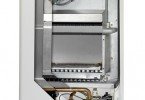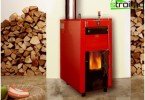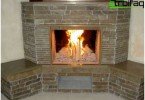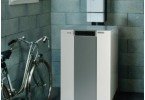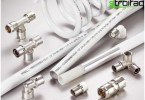Heating convectors
When installing a heating system and before buying heating appliances, the question suddenly arises, what equipment to install? Which is better, convectors or radiators? Heating convectors are relatively new heating appliances in the modern market, so not everyone knows their main advantages and disadvantages, and, therefore, cannot make a completely justified choice. In this article, we will try to highlight some of the “dark” sides of these devices and talk about the advantages of specific types.
Content
- Classification of convectors for heating systems
- Convectors for water circuits
- The device and principle of operation
- Advantages and disadvantages
- Electric convection systems
- The device and principle of operation
- Advantages and disadvantages of electric convectors
- Electric heating convectors – how to choose
- Gas convection equipment
- The principle of operation of gas convectors
- Advantages of gas convectors
Classification of convectors for heating systems
There are two ways to transfer heat from the surface of the heating element to the living room:
- By thermal radiation (cast iron, bimetal, aluminum radiators).
- Using convection flows (convectors).
In convection devices, heat transfer occurs due to the constant circulation of air through the device body, usually from the bottom up, since warm air is much lighter than cold.
At the location, all convectors can be divided into several types:
- wall mounted;
- floor;
- in-floor water;
- mounted;
- universal.
The main advantage of wall and floor devices is the ease of installation. Floor heating convectors are simply placed on the floor, and wall convectors are mounted on any vertical surface, for which it will be enough to drill just a few holes.
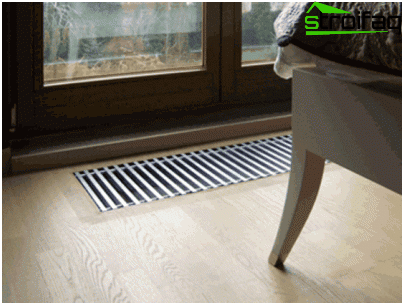
Installation of floor-mounted recessed convectors is very difficult
But the floor heating convectors require special training.
They are installed in pre-prepared niches, and for the high-quality performance of work a certain amount of technical skills and knowledge is needed. In addition, installation of built-in water convectors takes a lot of time.
Tip: If you have not yet decided on the location or the existing heating system does not cope with its main function and requires the installation of additional heating equipment, it is better to purchase station wagon heating convectors. Such devices can be hung on the wall or installed in the most convenient place on special legs.
Depending on the heating method, there are:
- water convectors;
- gas convectors;
- electric heating convectors.
We will talk about the benefits of each type in more detail..
Convectors for water circuits
You can already guess from the name that the coolant in such devices is water. Water heating convectors have replaced radiators and batteries that provide excellent heat transfer, but at the same time require a large amount of coolant. Another problem that owners of ordinary radiators face is the air congestion that forms in the system. Removing them is a rather unpleasant procedure, but in water convectors the occurrence of such a situation is impossible.
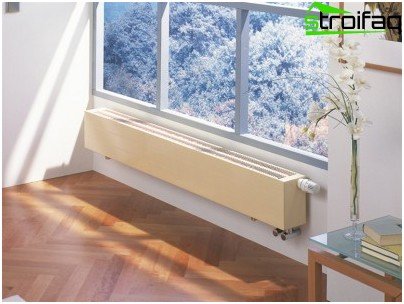
Water heating convector installed under the window – excellent thermal curtain
The device and principle of operation
The convector case is made of stainless steel, and its upper surface is closed by a lid. Depending on the design, this cover can either be removed or not. The device is connected to the heating pipes by the available inputs on the side or end side. All modern devices are equipped with an air damper designed to adjust the intensity of heated air masses, an air release valve and a valve that regulates the heating intensity by restricting the flow of coolant.
The main element – the heat exchanger – is a copper pipe on which metal plates are located, significantly increasing its area. Moreover, there should not be even a minimum gap between the ribs and the pipe, otherwise the heat transfer is significantly reduced.
The principle of action is all the same property of the ease of warm air. Only in convectors, rising upwards, air masses increase their speed with the help of a special fan. Very thin tubes are used in the design, and metals with high thermal conductivity are used as material for the plates, so that full heating to the maximum power declared by the manufacturer is possible in less than 15 minutes.
Advantages and disadvantages
Disadvantages:
- Such devices will not cope with heating a room with very high ceilings, since all the warm air will accumulate at the top.
- Drafts may occur due to uneven distribution of air flows.
- Dust circulation by convection flows.
- For rooms with heating by water convectors, forced ventilation must not be used. Taking air from the ceiling, it will bring all the warm air out.
Advantages:
- A good level of heating at low coolant temperatures, that is, a reduction in energy costs.
- Quick heat.
- The light weight of the device allows it to be mounted on plasterboard partitions.
- When installed under the windows, the water convector completely cuts off the cold air entering from the outside, acting as a thermal curtain.
Tip: when buying water convectors, pay attention to the body of the device and the connection hoses. They must be stainless steel to prevent corrosion..
Electric convection systems
These devices are very similar in appearance to oil heaters, only their case is slightly flatter. Electric wall heating convectors are mounted at a distance of 150 mm from the floor to a vertical surface (wall or partition), and in the presence of special legs are placed on the floor.
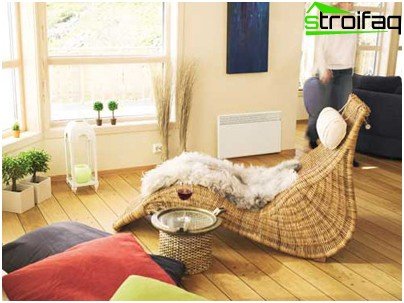
The mounted electric convector does not interfere with moving around the room, occupies a minimum of space
The device and principle of operation
Inside a flat metal case there is a heating element (TEN), on the entire surface of which there are plates or it is placed in an aluminum casing, designed to increase the surface area of the PETN.
Heating is carried out as follows: cold air through a small grill in the lower part of the device enters the heater and, when heated, rises and exits through the grill in the upper part. Heating convectors electrical consumer reviews lead in the leaders due to their silent operation, as they are not equipped with fans.
Advantages and disadvantages of electric convectors
Disadvantages:
- Significant reduction in efficiency and heating performance over time.
- High power consumption.
- Not suitable for large rooms, recommended only as an additional source of heating.
- Electric convectors dry the air very much and carry dust.
Advantages:
- Low cost.
- Easy installation and operation.
- Noiselessness.
- High efficiency – about 95%.
- Fast heating ten.
- No special maintenance required.
Electric heating convectors – how to choose
This question torments many consumers. Firstly, it is necessary to determine the area of the living space and select a device based on the ratio of 90 watts per 1 sq.m. Secondly, we specify which thermostat is in the convector. Mechanical, of course, is cheaper than electronic, but it is less accurate and is not able to quickly respond to lower temperatures. Thirdly, if you plan to heat a room with high humidity, you should buy a convector with protection against water IP24.
Important: be sure to purchase a device with automatic protection against overheating. This will avoid many troubles, such as a fire..
Gas convection equipment
Gas heating convectors are easy to install and operate. For their operation, no electrical connection is required if the device is not equipped with a fan. They can operate on both liquefied and natural gas..
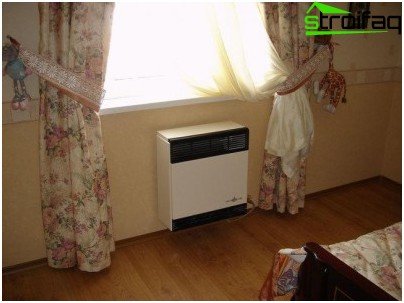
Option to install a gas convector under the window
The principle of operation of gas convectors
The basic principle of convectors is unchanged – air circulation in the device. Cold air enters the closed chamber and heats up when gas is burned, combustion products are thrown out through the chimney into the street. The chimneys of convectors are absolutely safe, even if they are discharged through a wooden wall. They are a coaxial tube, through the central passage of which decay products are released during combustion, and in the external circuit there is cold air, which prevents the heating of the chimney.
Advantages of gas convectors
- Simplicity of installation – the device just hangs on the wall.
- Safety operation.
- All materials of which convectors are made are environmentally friendly.
Important: to install a gas convector, you must invite specialists from gas companies.
The modern market range of convectors is very wide. Using the right choice of convectors, you can heat a small country house and a spacious country house, slightly heat the room on a cool autumn evening, or create a system that completely, and most importantly very quickly, raises the temperature of the room endlessly lasting in winter.


